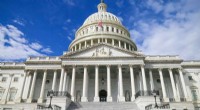
Wetenschap
Experts meten de economische impact van de COVID-19-pandemie

Krediet:CC0 Publiek Domein
Tussen 21 en 28 maart toen het land quarantainemaatregelen nam, de Verenigde Staten kende een 3, 000% stijging in aanvragen voor werkloosheid. Tegen eind maart, een beursdaling had alle winsten van de voorgaande drie jaar weggevaagd.
Maandenlang, gesloten restaurants, winkelpuien en kantoren doorboorde beelden van lege straten in New York City, Los Angeles en Venetië, Italië. De gevolgen van COVID-19 voor economieën over de hele wereld worden steeds duidelijker, en diep gevoeld door de miljoenen die werkloos blijven of wier bedrijven op de rand van faillissement staan.
Hoewel de Amerikaanse economie sinds het aanvankelijke dieptepunt wat back-banen heeft toegevoegd, Hawaii kampt met werkloosheid op het niveau van de Grote Depressie en in Kentucky wachten mensen acht uur in de rij om met iemand van het werkloosheidsbureau te praten.
Economen kwamen onlangs bijeen voor een online conferentie georganiseerd door het USC Dornsife College of Letters, Arts and Sciences' Department of Economics om de economische impact van COVID-19 te bespreken en hoe een ernstige wereldwijde recessie het beste kan worden vermeden.
Alles afsluiten, behalve de meest vitale operaties, was de sleutel om massale infecties en overlijden te voorkomen. maar het is een riskante strategie. "Je hebt de economie in een kunstmatige coma gebracht, om ontstekingen te verminderen, " zei Romain Ranciere, hoogleraar economie, financiën en bedrijfseconomie bij USC Dornsife. "Maar hoe snel zal het herstel gaan? Dat is de vraag."
De wereld rond in 180 dagen
In enkele van de zwaarst getroffen landen is het aantal besmettingen gedaald, zoals Italië en Spanje. China heropent de provincie Wuhan, voorheen het epicentrum van het virus. Lente en zomer zorgden voor hogere temperaturen op het noordelijk halfrond, wat een goed voorteken is voor degenen die er momenteel middenin zitten - vroeg onderzoek toont aan dat het virus niet van warme, vochtige omgevingen.
Maar terwijl de noordelijke landen zich koesteren in zonniger dagen, het zuidelijk halfrond stort zich in de winter. Dit zou een significante toename van het aantal besmettingen onder de evenaar kunnen betekenen, naarmate de omstandigheden voor het virus verbeteren en koudere temperaturen mensen samen naar besloten ruimtes sturen.
"Er is een terugkaatsend effect tussen de twee hersenhelften, " zei Ranciere. Deze rebound zou kunnen betekenen dat, net zoals het noordelijk halfrond zich veilig voelt om uit quarantaine te komen, het virus komt brullend terug na overwintering in het zuiden. Gelijke inperkingsmaatregelen aan beide zijden van de evenaar zijn essentieel.
Echter, veel van 's werelds opkomende economieën bevinden zich op het zuidelijk halfrond, wat het probleem van seizoensgebonden rebound compliceert. "De strategie voor geavanceerde economieën is grotendeels onbereikbaar voor opkomende economieën, " zei Pierre-Olivier Gourinchas, hoogleraar economie aan de Universiteit van Californië, Berkeley.
Ontwikkelingslanden hebben niet de financiële middelen om burgers te betalen om thuis te blijven van hun werk. Het verminderen van de infectiesnelheid, of "de curve afvlakken, " wordt een grote uitdaging wanneer werknemers het huis moeten verlaten om hun gezin te voeden. Een slechte gezondheidszorginfrastructuur en beperkte toegang tot schoon water en zeep voor basishygiëne vergroten de kans op overdracht. Economieën die afhankelijk zijn van het leveren van goederen aan rijkere landen, kampen met opschorting van handel, verder leegmaken van de staatskas.
Rijkere landen zijn misschien bezig met hun eigen pandemische problemen, maar ze mogen opkomende economieën niet negeren, zei Gourinchas. Door financiële steun te bieden zodat alle landen strategieën kunnen uitvoeren, zoals onderdak, wordt het virus wereldwijd onderdrukt en wordt ieders economisch herstel gestimuleerd.
"Herstel van de pandemie, en de recessie, zal sneller zijn als het wereldwijd is, ’ betoogde hij.
Natuurlijk, nu de economische druk en de kosten voor de gezondheidszorg omhoogschieten, even established economies may struggle to help anyone but themselves. This is true in some wealthier countries, including the United States and the United Kingdom, who seem unable to reverse the upward trend in infection rates.
Chain reactions
Established economies are also grappling with supply chain disruptions. The U.S. imports 90% of generic medications from India and China. Lockdowns in these countries threaten U.S. supplies as factory workers stay home and production stops.
Aanvullend, some nations banned the export of certain medications outside the country, which could have led to drug shortages in countries that rely on these manufacturers. India restricted export of 26 medications, including acetaminophen, a commonly used pain reliever. In part this was due to their own reliance on China for the raw materials to manufacture these drugs. With Chinese manufacturing running at reduced capacity, resources for drug production are in short supply.
India eventually reversed the medication export ban, but items like N95 masks, which are also overwhelmingly produced abroad, remain exceedingly difficult to procure.
"All this reveals that global chains are much more sensitive and fragile than we thought, " Rainciere said.
Our food supply chains also face obstacles, particularly in California. Much of the produce grown in the state requires hands-on harvesting, including grapes, lettuce, and strawberries, unlike grain production in Midwestern states, which can use unmanned machinery.
Harvesters are grappling with a backlog of unprocessed agricultural H-2A visas, which many foreign fieldworkers must obtain to work in the state. The pandemic and recent federal policies have essentially shut down visa processing.
Without stringent precautions, COVID-19 can spread rapidly among workers, who are often housed in rooms with up to 24 people, worsening the worker shortage and leaving produce to rot in the field, causing California's economy to sag.
Who's footing the bill?
The U.S. House recently approved America's newest COVID-19 relief bill—a staggering $3 trillion in assistance to citizens and businesses beyond the first infusion of $2 trillion in March. Other countries passed similar packages.
Each bill differs in the focus of its relief, says Ricardo Reis, professor of economics at the London School of Economics. "There is a mix between helping vulnerable individuals vs. helping businesses. European packages are very focused on 'going concern' with businesses. The U.S. package is very much driven toward social insurance, which makes sense because there are holes in the safety nets here."
Regardless of where the relief is headed, these sorts of eye-popping sums raise the questions of who pays for it all.
Some countries have adopted a strategy of "partial employment." Under this plan, employers retain their workers and pay a portion of their employee's salary while the government pitches in the rest. In Germany, 60% of a worker's wage is guaranteed if the employer pays a stipend, and in Denmark, 90% is guaranteed. Employers won't need to worry about recruiting and training new workers once the pandemic eases, which makes economic recovery swifter, and the government receives a helping hand in supporting citizens monetarily.
Increased taxation will likely play a role, particularly when it comes to health care costs. "When you look at health systems, you will see higher pressure for taxation to cover this, " said Ranciere.
Most advanced economies already provide taxpayer funded universal health care. In the U.S., where insurance is mostly tied to employment, millions have suddenly found themselves without coverage and unable to afford private insurance rates. Support for a taxpayer funded universal health care system that doesn't rely on employment for access appears to be rising among Americans during this crisis.
"The question of whether health is a public good or a private good is being reconsidered. We're learning that health is a public good—if you don't insure everyone, they will infect other people, " Ranciere said.
Opening the gates
As the country begins to emerge from lockdown, the most pressing concern is how to allow people to return to work to avoid serious economic damage, but without worsening the pandemic. Until a vaccine emerges, the virus will likely continue to spread unless social distancing is maintained. Zelfs dan, COVID-19 could mutate and reemerge seasonally like influenza.
Countries that enact strong social safety nets that help people stay housed and fed during this time can avoid many of the health ramifications that occur during traditional economic downtowns, which leave people destitute and unmoored.
Allowing those without the virus to leave confinement while those infected, and the immune compromised, remain at home may be our best bet at allowing the economy to safely and effectively rev up again. In the U.S., this would require a significant increase in testing and contact tracing. Helaas, the country still faces a shortage of tests months after the outbreak began. This may mean getting creative.
Ranciere described a wartime strategy for avoiding the spread of STIs that could help. Tasked with testing WWII U.S. Army recruits for syphilis but stymied by the cost of individual blood tests, Robert Dorfman at Harvard University devised a method for group testing instead. Drawing blood from 10 recruits, the samples were mixed and then tested as one. If no disease was present, the whole group could be released. As more folks form "quarantine bubbles" in the face of extended isolation, group testing could make increasing sense.
Similar testing strategies could help as citizens return to work—and keep the economy more productive while we await the arrival of that hallowed vaccine.
 Hier zijn drie manieren waarop steden zich kunnen aanpassen aan veranderende klimaten
Hier zijn drie manieren waarop steden zich kunnen aanpassen aan veranderende klimaten Onderzoekers bestuderen milieu, menselijke gevolgen van een nucleaire oorlog
Onderzoekers bestuderen milieu, menselijke gevolgen van een nucleaire oorlog Nu het Amerikaanse voetbalseizoen van start gaat, klimaatverandering bedreigt het spel
Nu het Amerikaanse voetbalseizoen van start gaat, klimaatverandering bedreigt het spel Het wel en wee van een megameer
Het wel en wee van een megameer Doden door zware moesson stijgen tot bijna 140 in Oost-India
Doden door zware moesson stijgen tot bijna 140 in Oost-India
Hoofdlijnen
- De voor- en nadelen van mutatie
- Het ochtendkoor horen:Okina was een nieuw akoestisch monitoringnetwerk
- Hoe Tiny Robots je gezondheid kunnen verbeteren vanuit het lichaam
- Waarom het uitsterven van parasieten een probleem kan zijn voor bedreigde woylies
- Onderzoekers rapporteren tandeloze bevindingen in odontode-dragende meervalstudie
- Zowel chimpansees als kinderen bleken bereid te betalen om slechte spelers gestraft te zien
- Genomisch onderzoek onthult aanwijzingen voor het wilde verleden van druiven
- Algen en krill kunnen moeilijk te verkopen zijn voor Europese consumenten
- Tot 50% minder fytosanitaire producten nodig om wijnstokziekten te behandelen
- Opnames van het magnetische veld van 9, 000 jaar geleden leer ons vandaag over het magnetische veld

- Onderzoek suggereert dat financiële belangen de belangrijkste stemmen voor huiswetgevers hebben beïnvloed

- Met deze vier eenvoudige stappen kun je een rekenwonder worden

- Sociaal-economische status in de VS moeilijker te veranderen dan ooit in de afgelopen 150 jaar

- Ras, etniciteit geen factor in recent wapendragend gedrag op Amerikaanse scholen

 Wetenschappers racen om te voorkomen dat de koraalriffen ter wereld verdwijnen
Wetenschappers racen om te voorkomen dat de koraalriffen ter wereld verdwijnen Een derde van de wereldwijde landbouwgrond met een hoog risico op vervuiling door pesticiden
Een derde van de wereldwijde landbouwgrond met een hoog risico op vervuiling door pesticiden Is het beleid ter bevordering van het fietsgebruik maatschappelijk rendabel?
Is het beleid ter bevordering van het fietsgebruik maatschappelijk rendabel? Antimicrobiële coatings met een langdurig effect voor oppervlakken
Antimicrobiële coatings met een langdurig effect voor oppervlakken Studies van Crater Capital in de Baltische staten laten een indrukwekkende geschiedenis zien
Studies van Crater Capital in de Baltische staten laten een indrukwekkende geschiedenis zien Nieuwe nanotech zal een gezonde productie van elektrische stroom in het menselijk lichaam mogelijk maken
Nieuwe nanotech zal een gezonde productie van elektrische stroom in het menselijk lichaam mogelijk maken NASA Wallops 7 mei raketlancering onderzoekt energietransport in de ruimte
NASA Wallops 7 mei raketlancering onderzoekt energietransport in de ruimte eenvoudiger, sneller en goedkoper:een volledig vullende benadering om koolstofnanobuisjes van constante kwaliteit te maken
eenvoudiger, sneller en goedkoper:een volledig vullende benadering om koolstofnanobuisjes van constante kwaliteit te maken
- Elektronica
- Biologie
- Zonsverduistering
- Wiskunde
- French | Italian | Spanish | Portuguese | Swedish | German | Dutch | Danish | Norway |

-
Wetenschap © https://nl.scienceaq.com

